engine coolant lexus LC500C 2021 / LEXUS 2021 LC500 CONVERTIBLE (OM11498U) User Guide
[x] Cancel search | Manufacturer: LEXUS, Model Year: 2021, Model line: LC500C, Model: Lexus LC500C 2021Pages: 410, PDF Size: 8.71 MB
Page 278 of 410
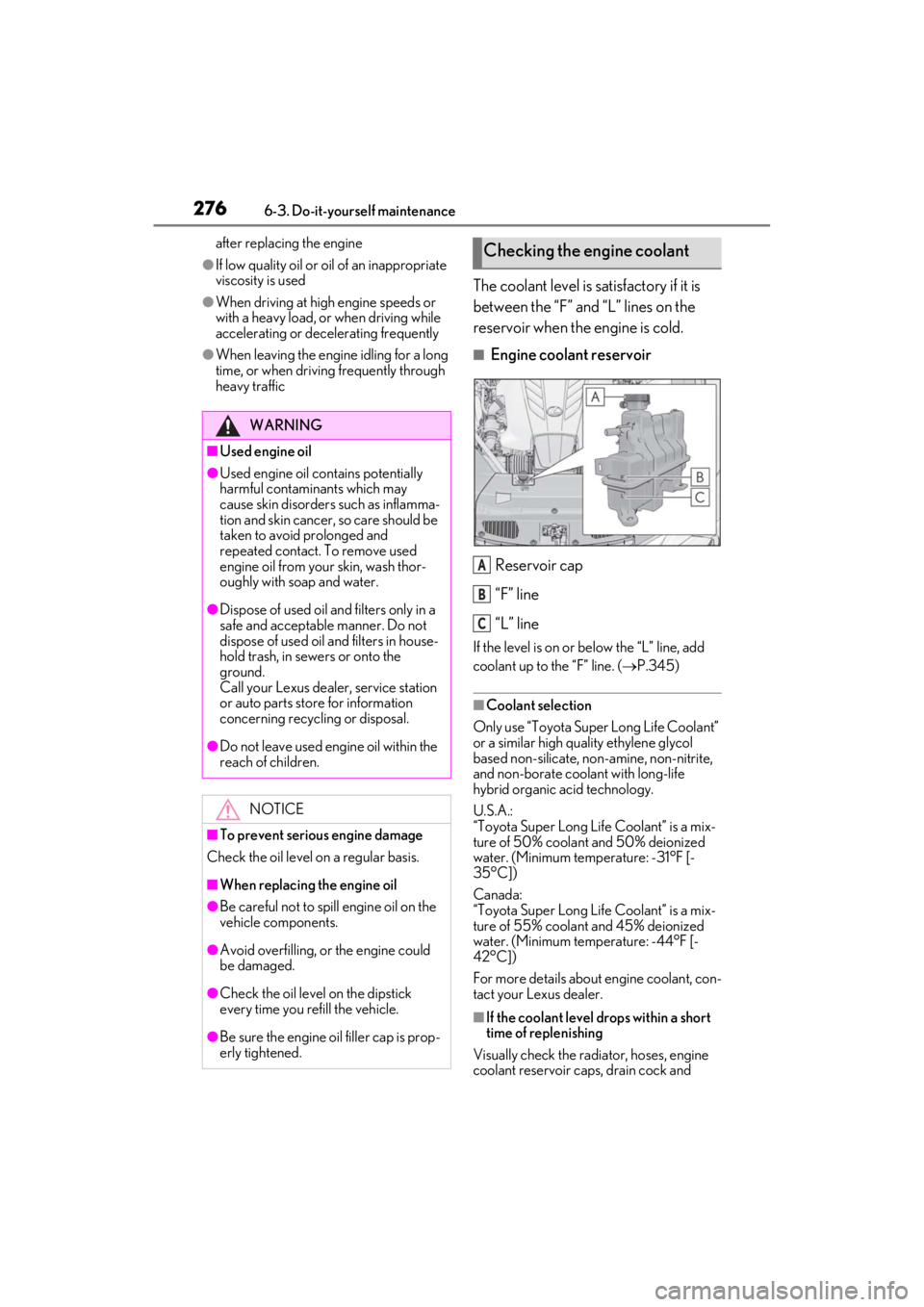
2766-3. Do-it-yourself maintenance
after replacing the engine
●If low quality oil or oil of an inappropriate
viscosity is used
●When driving at high engine speeds or
with a heavy load, or when driving while
accelerating or decelerating frequently
●When leaving the engine idling for a long
time, or when driving frequently through
heavy traffic
The coolant level is satisfactory if it is
between the “F” and “L” lines on the
reservoir when the engine is cold.
■Engine coolant reservoirReservoir cap
“F” line
“L” line
If the level is on or below the “L” line, add
coolant up to the “F” line. ( P.345)
■Coolant selection
Only use “Toyota Super Long Life Coolant”
or a similar high quality ethylene glycol
based non-silicate, non-amine, non-nitrite,
and non-borate coolant with long-life
hybrid organic acid technology.
U.S.A.:
“Toyota Super Long Life Coolant” is a mix-
ture of 50% coolant and 50% deionized
water. (Minimum temperature: -31°F [-
35°C])
Canada:
“Toyota Super Long Life Coolant” is a mix-
ture of 55% coolant and 45% deionized
water. (Minimum temperature: -44°F [-
42°C])
For more details about engine coolant, con-
tact your Lexus dealer.
■If the coolant level drops within a short
time of replenishing
Visually check the radi ator, hoses, engine
coolant reservoir caps, drain cock and
WARNING
■Used engine oil
●Used engine oil contains potentially
harmful contaminants which may
cause skin disorders such as inflamma-
tion and skin cancer, so care should be
taken to avoid prolonged and
repeated contact. To remove used
engine oil from your skin, wash thor-
oughly with soap and water.
●Dispose of used oil and filters only in a
safe and acceptable manner. Do not
dispose of used oil and filters in house-
hold trash, in sewers or onto the
ground.
Call your Lexus dealer, service station
or auto parts store for information
concerning recycling or disposal.
●Do not leave used engine oil within the
reach of children.
NOTICE
■To prevent serious engine damage
Check the oil level on a regular basis.
■When replacing the engine oil
●Be careful not to spill engine oil on the
vehicle components.
●Avoid overfilling, or the engine could
be damaged.
●Check the oil level on the dipstick
every time you refill the vehicle.
●Be sure the engine oi l filler cap is prop-
erly tightened.
Checking the engine coolant
A
B
C
Page 279 of 410
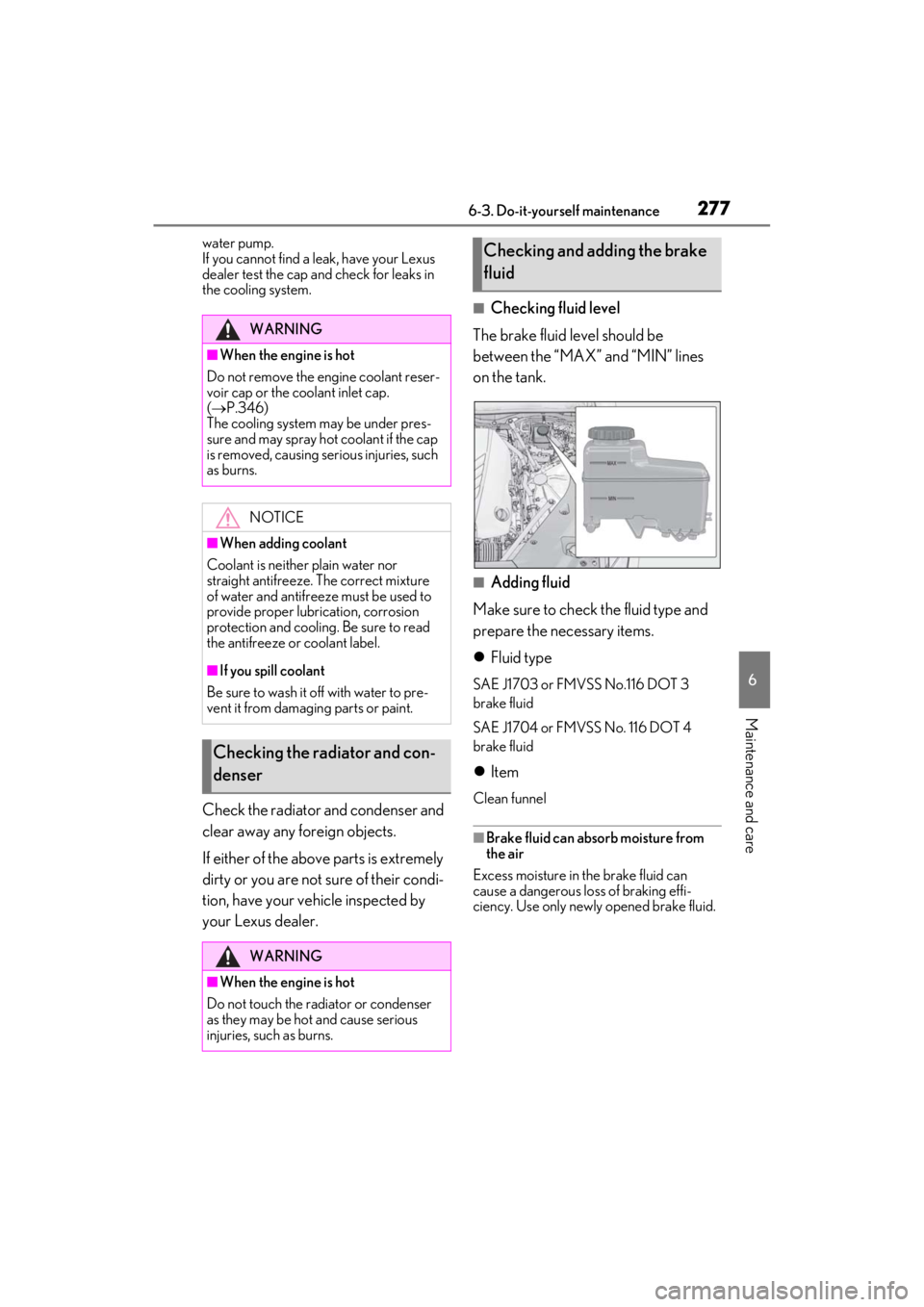
2776-3. Do-it-yourself maintenance
6
Maintenance and care
water pump.
If you cannot find a leak, have your Lexus
dealer test the cap and check for leaks in
the cooling system.
Check the radiator and condenser and
clear away any foreign objects.
If either of the above parts is extremely
dirty or you are not sure of their condi-
tion, have your vehicle inspected by
your Lexus dealer.
■Checking fluid level
The brake fluid level should be
between the “MAX” and “MIN” lines
on the tank.
■Adding fluid
Make sure to check the fluid type and
prepare the necessary items.
Fluid type
SAE J1703 or FMVSS No.116 DOT 3
brake fluid
SAE J1704 or FMVSS No. 116 DOT 4
brake fluid
Item
Clean funnel
■Brake fluid can absorb moisture from
the air
Excess moisture in the brake fluid can
cause a dangerous loss of braking effi-
ciency. Use only newly opened brake fluid.
WARNING
■When the engine is hot
Do not remove the engine coolant reser-
voir cap or the coolant inlet cap.
( P.346)
The cooling system may be under pres-
sure and may spray hot coolant if the cap
is removed, causing serious injuries, such
as burns.
NOTICE
■When adding coolant
Coolant is neither plain water nor
straight antifreeze. The correct mixture
of water and antifreeze must be used to
provide proper lubrication, corrosion
protection and cooling. Be sure to read
the antifreeze or coolant label.
■If you spill coolant
Be sure to wash it off with water to pre-
vent it from damagi ng parts or paint.
Checking the radiator and con-
denser
WARNING
■When the engine is hot
Do not touch the radiator or condenser
as they may be hot and cause serious
injuries, such as burns.
Checking and adding the brake
fluid
Page 314 of 410
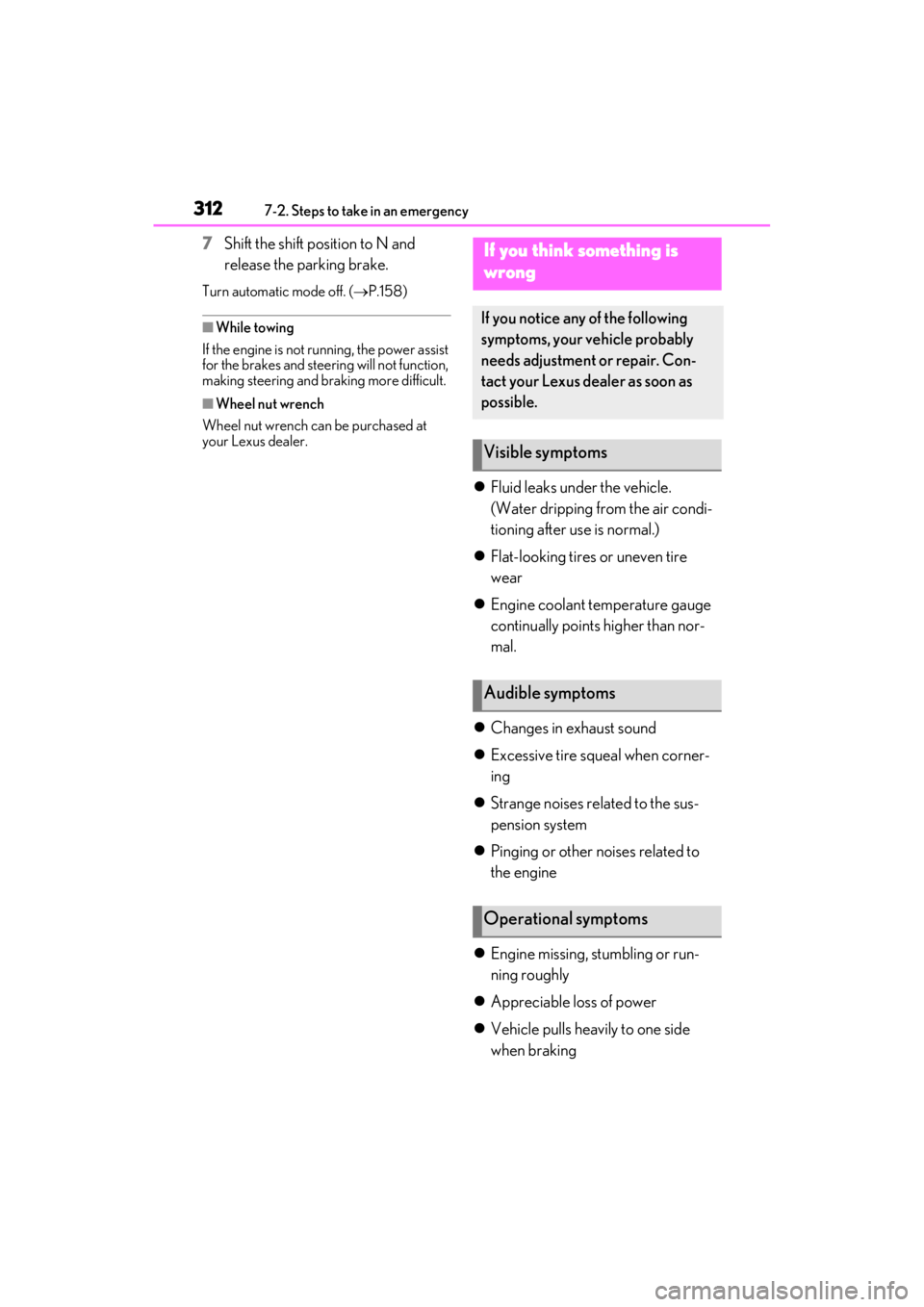
3127-2. Steps to take in an emergency
7Shift the shift position to N and
release the parking brake.
Turn automatic mode off. ( P.158)
■While towing
If the engine is not running, the power assist
for the brakes and steering will not function,
making steering and braking more difficult.
■Wheel nut wrench
Wheel nut wrench can be purchased at
your Lexus dealer.
Fluid leaks under the vehicle.
(Water dripping from the air condi-
tioning after use is normal.)
Flat-looking tires or uneven tire
wear
Engine coolant temperature gauge
continually points higher than nor-
mal.
Changes in exhaust sound
Excessive tire squeal when corner-
ing
Strange noises related to the sus-
pension system
Pinging or other noises related to
the engine
Engine missing, stumbling or run-
ning roughly
Appreciable loss of power
Vehicle pulls heavily to one side
when braking
If you think something is
wrong
If you notice any of the following
symptoms, your vehicle probably
needs adjustment or repair. Con-
tact your Lexus dealer as soon as
possible.
Visible symptoms
Audible symptoms
Operational symptoms
Page 321 of 410
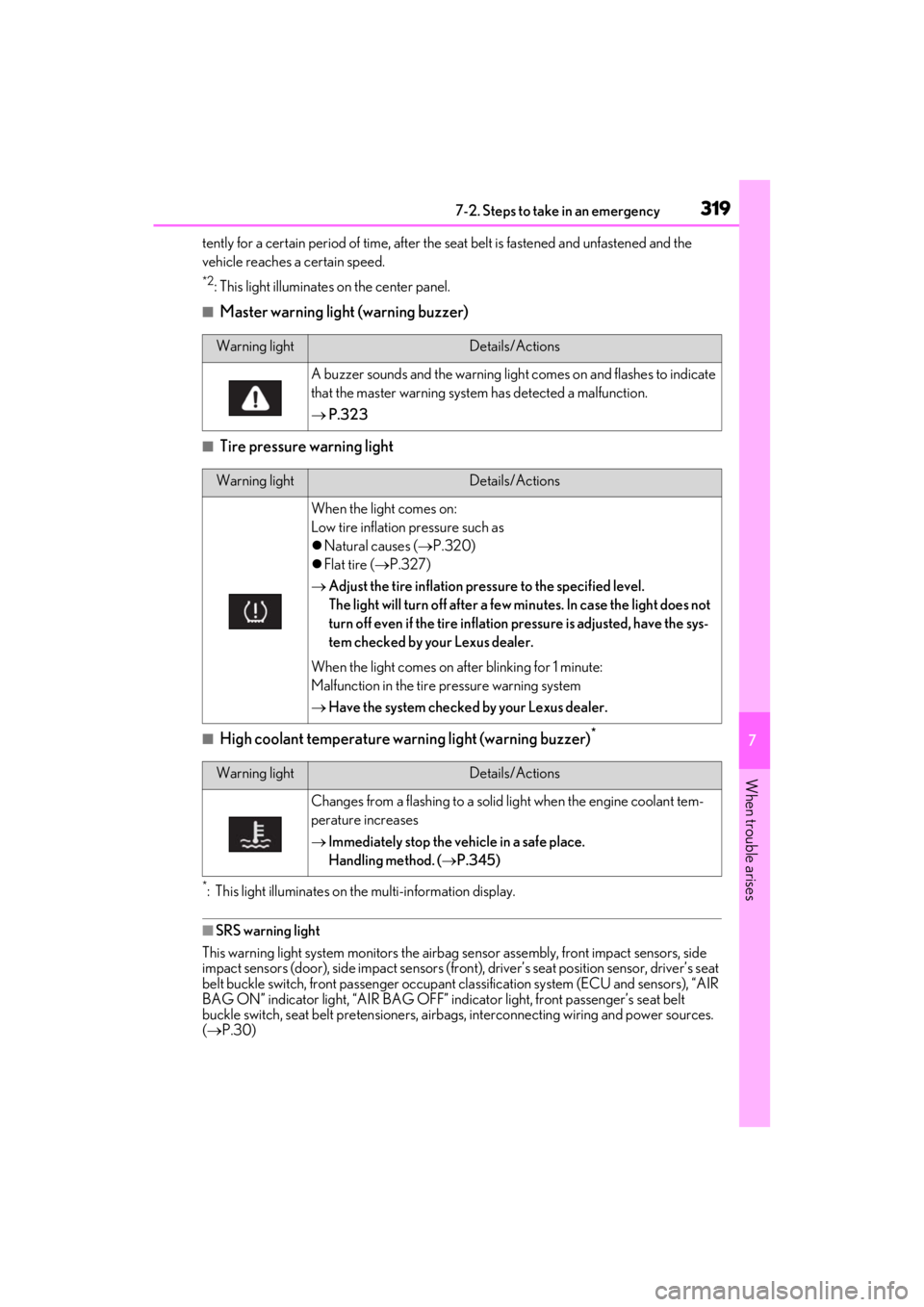
3197-2. Steps to take in an emergency
7
When trouble arises
tently for a certain period of time, after the seat belt is fastened and unfastened and the
vehicle reaches a certain speed.
*2: This light illuminates on the center panel.
■Master warning light (warning buzzer)
■Tire pressure warning light
■High coolant temperature warning light (warning buzzer)*
*: This light illuminates on the multi-information display.
■SRS warning light
This warning light system monitors the airbag sensor assembly, front impact sensors, side
impact sensors (door), side impact sensors (front), driver’s seat position sensor, driver’s seat
belt buckle switch, front passenger occupant classification sy stem (ECU and sensors), “AIR
BAG ON” indicator light, “AIR BAG OFF” indicator light, front passenger’s seat belt
buckle switch, seat belt preten sioners, airbags, interconnecting wiring and power sources.
( P.30)
Warning lightDetails/Actions
A buzzer sounds and the warning ligh t comes on and flashes to indicate
that the master warning system has detected a malfunction.
P.323
Warning lightDetails/Actions
When the light comes on:
Low tire inflation pressure such as
Natural causes ( P.320)
Flat tire ( P.327)
Adjust the tire inflation pressure to the specified level.
The light will turn off after a few mi nutes. In case the light does not
turn off even if the tire inflation pressure is adjusted, have the sys-
tem checked by your Lexus dealer.
When the light comes on after blinking for 1 minute:
Malfunction in the tire pressure warning system
Have the system checked by your Lexus dealer.
Warning lightDetails/Actions
Changes from a flashing to a solid light when the engine coolant tem-
perature increases
Immediately stop the vehicle in a safe place.
Handling method. ( P.345)
Page 328 of 410
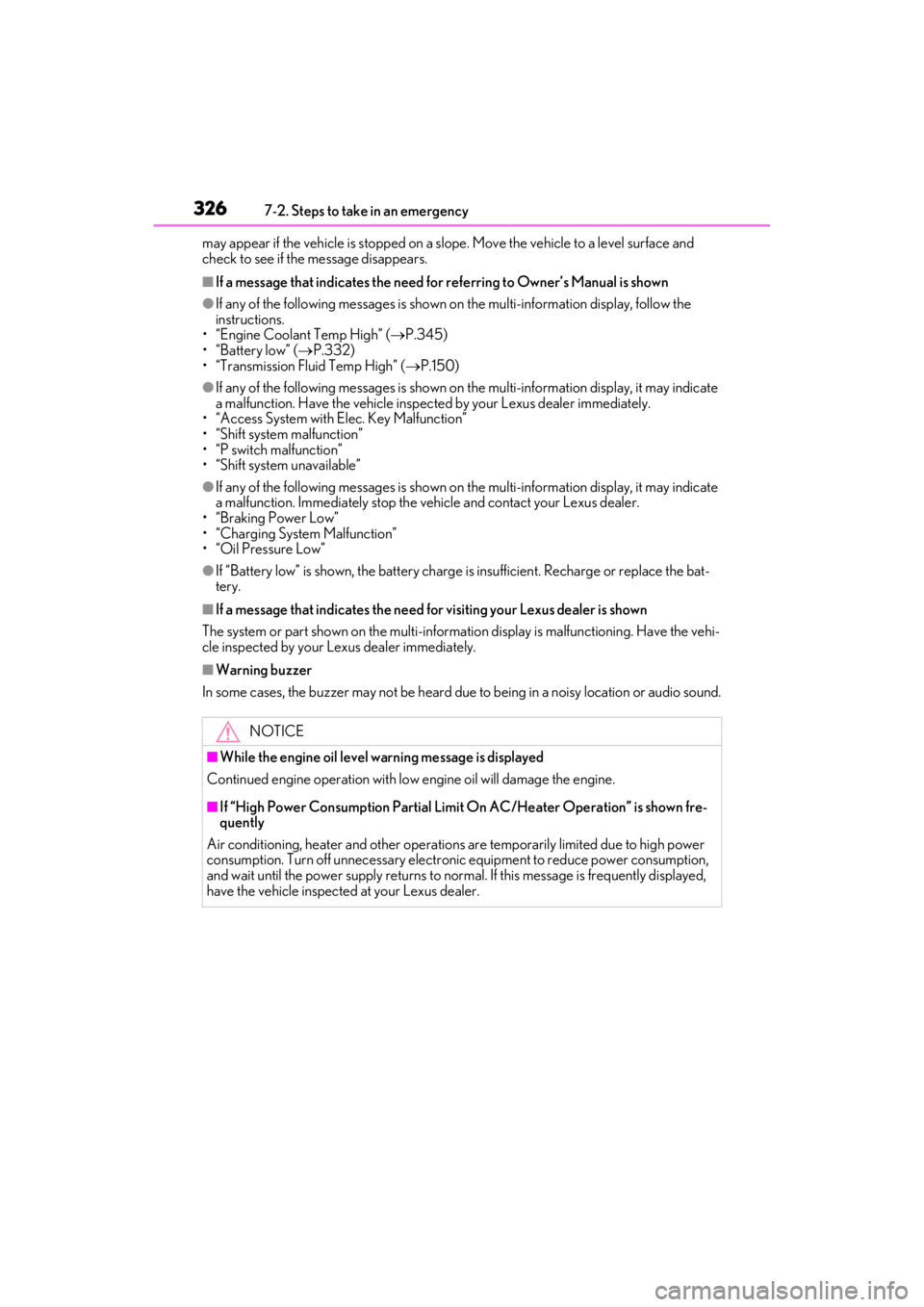
3267-2. Steps to take in an emergency
may appear if the vehicle is stopped on a slope. Move the vehicle to a level surface and
check to see if the message disappears.
■If a message that indicates the need for referring to Owner’s Manual is shown
●If any of the following messages is shown on the multi-information display, follow the
instructions.
• “Engine Coolant Temp High” ( P.345)
• “Battery low” ( P.332)
• “Transmission Fluid Temp High” ( P.150)
●If any of the following messages is shown on the multi-information di splay, it may indicate
a malfunction. Have the vehicle inspected by your Lexus dealer immediately.
• “Access System with Elec. Key Malfunction”
• “Shift system malfunction”
• “P switch malfunction”
• “Shift system unavailable”
●If any of the following messages is shown on the multi-information di splay, it may indicate
a malfunction. Immediately stop the vehicle and contact your Lexus dealer.
• “Braking Power Low”
• “Charging System Malfunction”
• “Oil Pressure Low”
●If “Battery low” is shown, the battery charge is insufficient . Recharge or replace the bat-
tery.
■If a message that indicates the need for visiting your Lexus dealer is shown
The system or part shown on the multi-information display is malfunctioning. Have the vehi-
cle inspected by your Lexus dealer immediately.
■Warning buzzer
In some cases, the buzzer may not be heard du e to being in a noisy location or audio sound.
NOTICE
■While the engine oil level warning message is displayed
Continued engine operation with low engine oil will damage the engine.
■If “High Power Consumption Partial Limit On AC/Heater Operation” is shown fre-
quently
Air conditioning, heater and other operations are temporarily limited due to high power
consumption. Turn off unnecessary electronic equipment to reduce power consumption,
and wait until the power supply returns to normal. If this message is frequently displayed,
have the vehicle inspected at your Lexus dealer.
Page 347 of 410
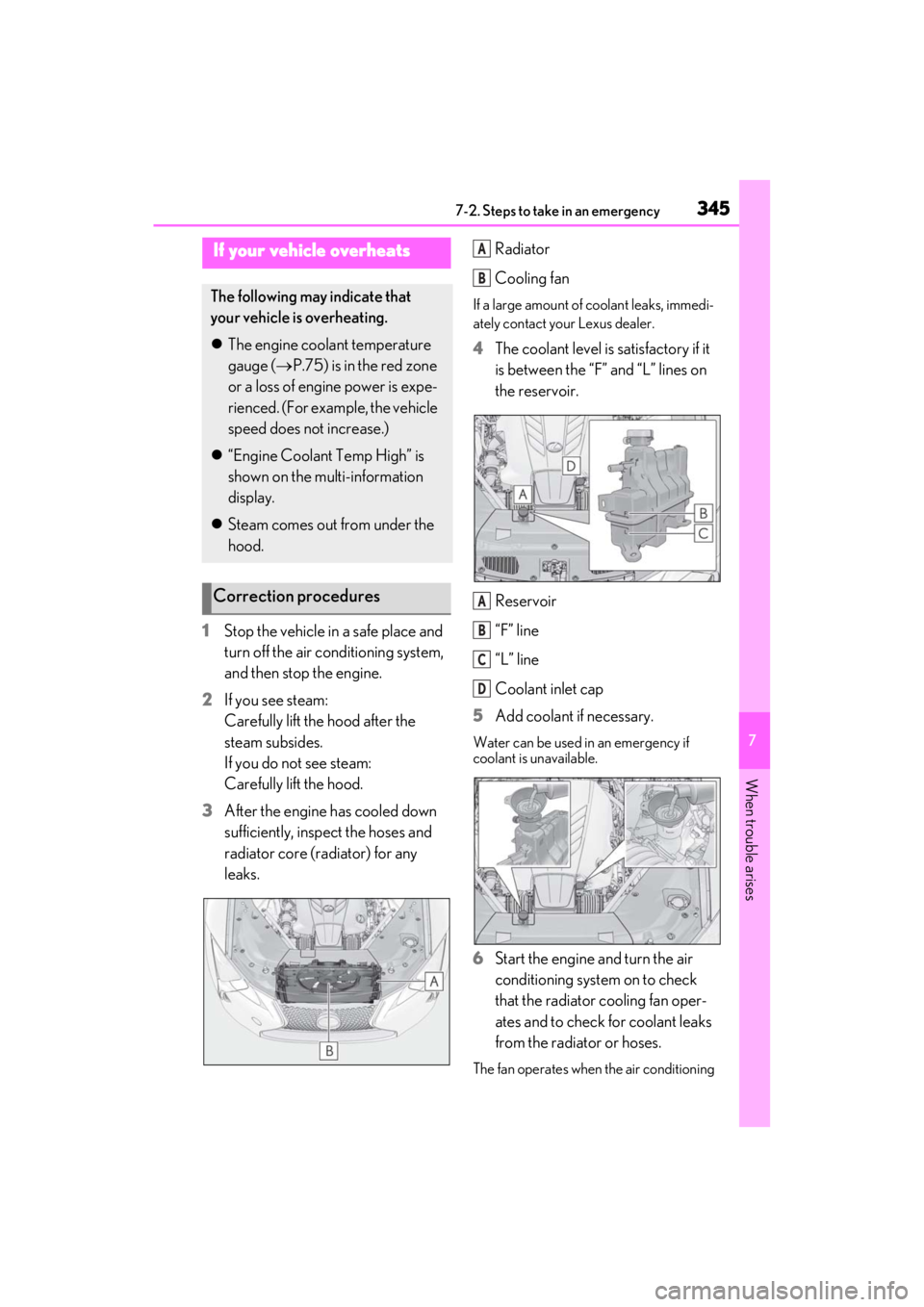
3457-2. Steps to take in an emergency
7
When trouble arises
1Stop the vehicle in a safe place and
turn off the air conditioning system,
and then stop the engine.
2 If you see steam:
Carefully lift the hood after the
steam subsides.
If you do not see steam:
Carefully lift the hood.
3 After the engine has cooled down
sufficiently, inspect the hoses and
radiator core (radiator) for any
leaks. Radiator
Cooling fan
If a large amount of coolant leaks, immedi-
ately contact your Lexus dealer.
4
The coolant level is satisfactory if it
is between the “F” and “L” lines on
the reservoir.
Reservoir
“F” line
“L” line
Coolant inlet cap
5 Add coolant if necessary.
Water can be used in an emergency if
coolant is unavailable.
6Start the engine and turn the air
conditioning system on to check
that the radiator cooling fan oper-
ates and to check for coolant leaks
from the radiator or hoses.
The fan operates when the air conditioning
If your vehicle overheats
The following may indicate that
your vehicle is overheating.
The engine coolant temperature
gauge ( P.75) is in the red zone
or a loss of engine power is expe-
rienced. (For example, the vehicle
speed does not increase.)
“Engine Coolant Temp High” is
shown on the multi-information
display.
Steam comes out from under the
hood.
Correction procedures
A
B
A
B
C
D
Page 348 of 410
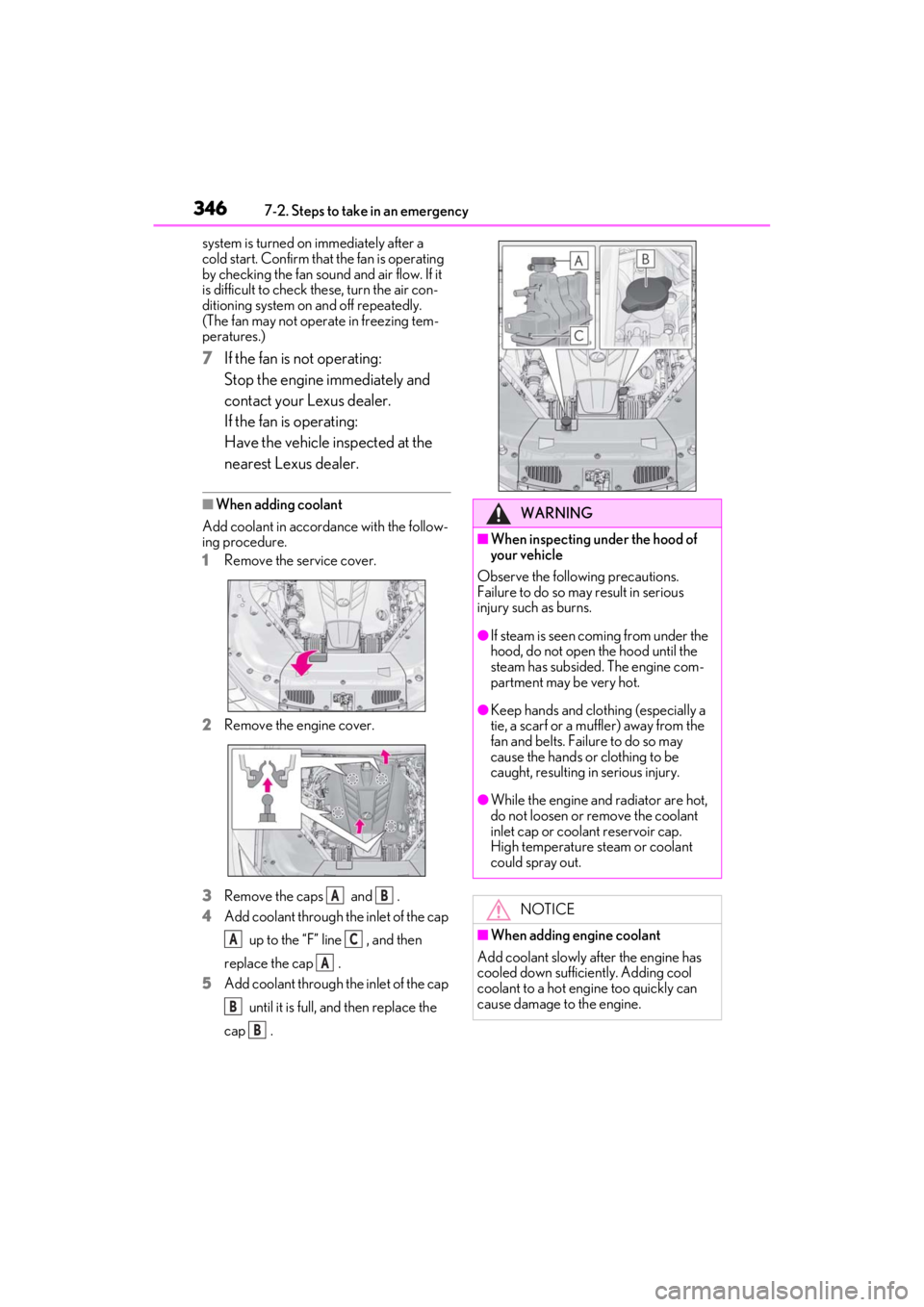
3467-2. Steps to take in an emergency
system is turned on immediately after a
cold start. Confirm that the fan is operating
by checking the fan sound and air flow. If it
is difficult to check these, turn the air con-
ditioning system on and off repeatedly.
(The fan may not operate in freezing tem-
peratures.)
7If the fan is not operating:
Stop the engine immediately and
contact your Lexus dealer.
If the fan is operating:
Have the vehicle inspected at the
nearest Lexus dealer.
■When adding coolant
Add coolant in accordance with the follow-
ing procedure.
1
Remove the service cover.
2
Remove the engine cover.
3
Remove the caps and .
4
Add coolant through the inlet of the cap
up to the “F” line , and then
replace the cap .
5
Add coolant through the inlet of the cap
until it is full, and then replace the
cap .
AB
AC
A
B
B
WARNING
■When inspecting under the hood of
your vehicle
Observe the following precautions.
Failure to do so may result in serious
injury such as burns.
●If steam is seen coming from under the
hood, do not open the hood until the
steam has subsided. The engine com-
partment may be very hot.
●Keep hands and clothing (especially a
tie, a scarf or a muffler) away from the
fan and belts. Failure to do so may
cause the hands or clothing to be
caught, resulting in serious injury.
●While the engine and radiator are hot,
do not loosen or remove the coolant
inlet cap or coolant reservoir cap.
High temperature steam or coolant
could spray out.
NOTICE
■When adding engine coolant
Add coolant slowly after the engine has
cooled down sufficiently. Adding cool
coolant to a hot engine too quickly can
cause damage to the engine.
Page 349 of 410
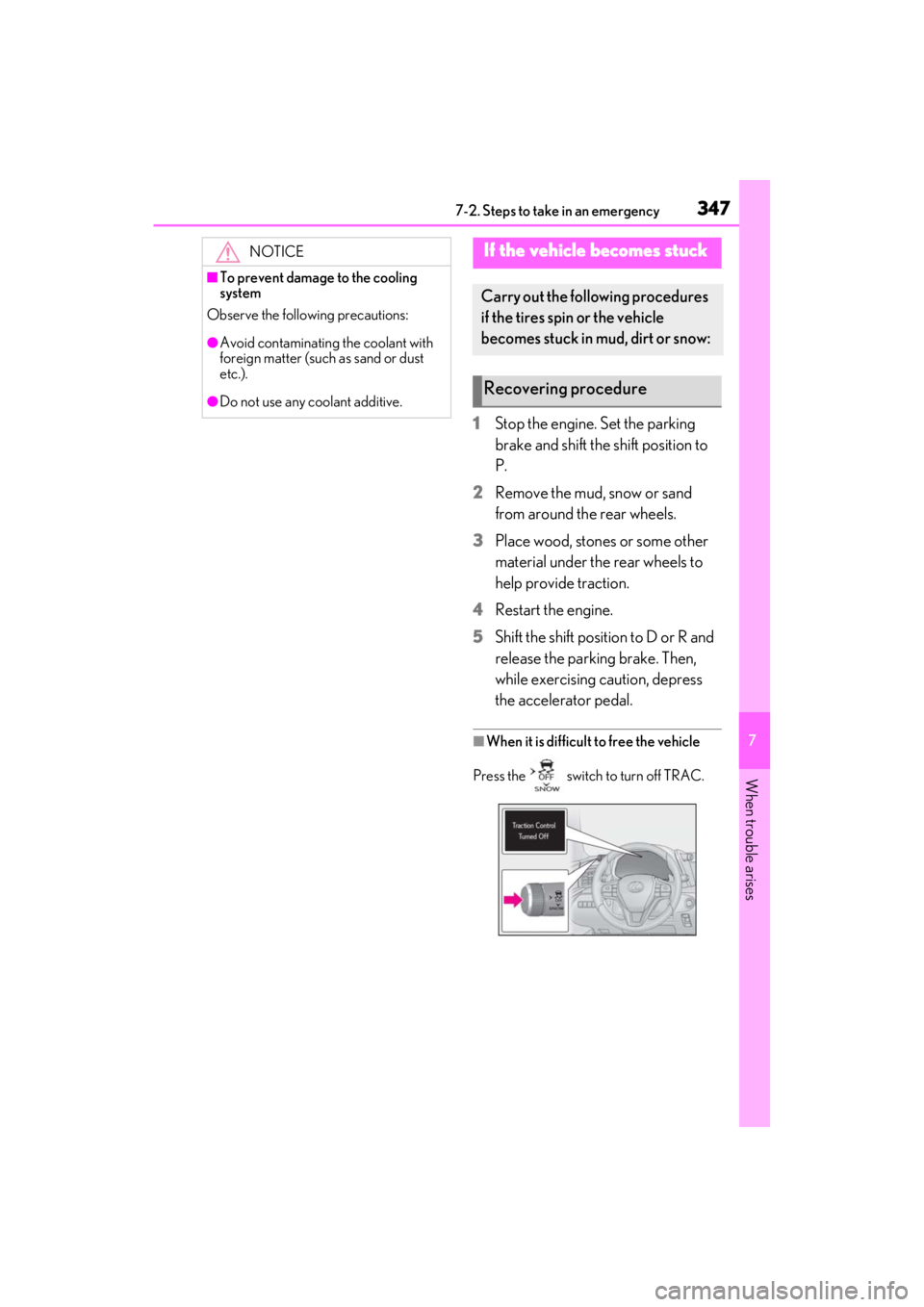
3477-2. Steps to take in an emergency
7
When trouble arises
1Stop the engine. Set the parking
brake and shift the shift position to
P.
2
Remove the mud, snow or sand
from around the rear wheels.
3
Place wood, stones or some other
material under the rear wheels to
help provide traction.
4
Restart the engine.
5
Shift the shift position to D or R and
release the parking brake. Then,
while exercising caution, depress
the accelerator pedal.
■When it is difficult to free the vehicle
Press the switch to turn off TRAC.
NOTICE
■To prevent damage to the cooling
system
Observe the following precautions:
●Avoid contaminating the coolant with
foreign matter (such as sand or dust
etc.).
●Do not use any coolant additive.
If the vehicle becomes stuck
Carry out the following procedures
if the tires spin or the vehicle
becomes stuck in mud, dirt or snow:
Recovering procedure
Page 354 of 410
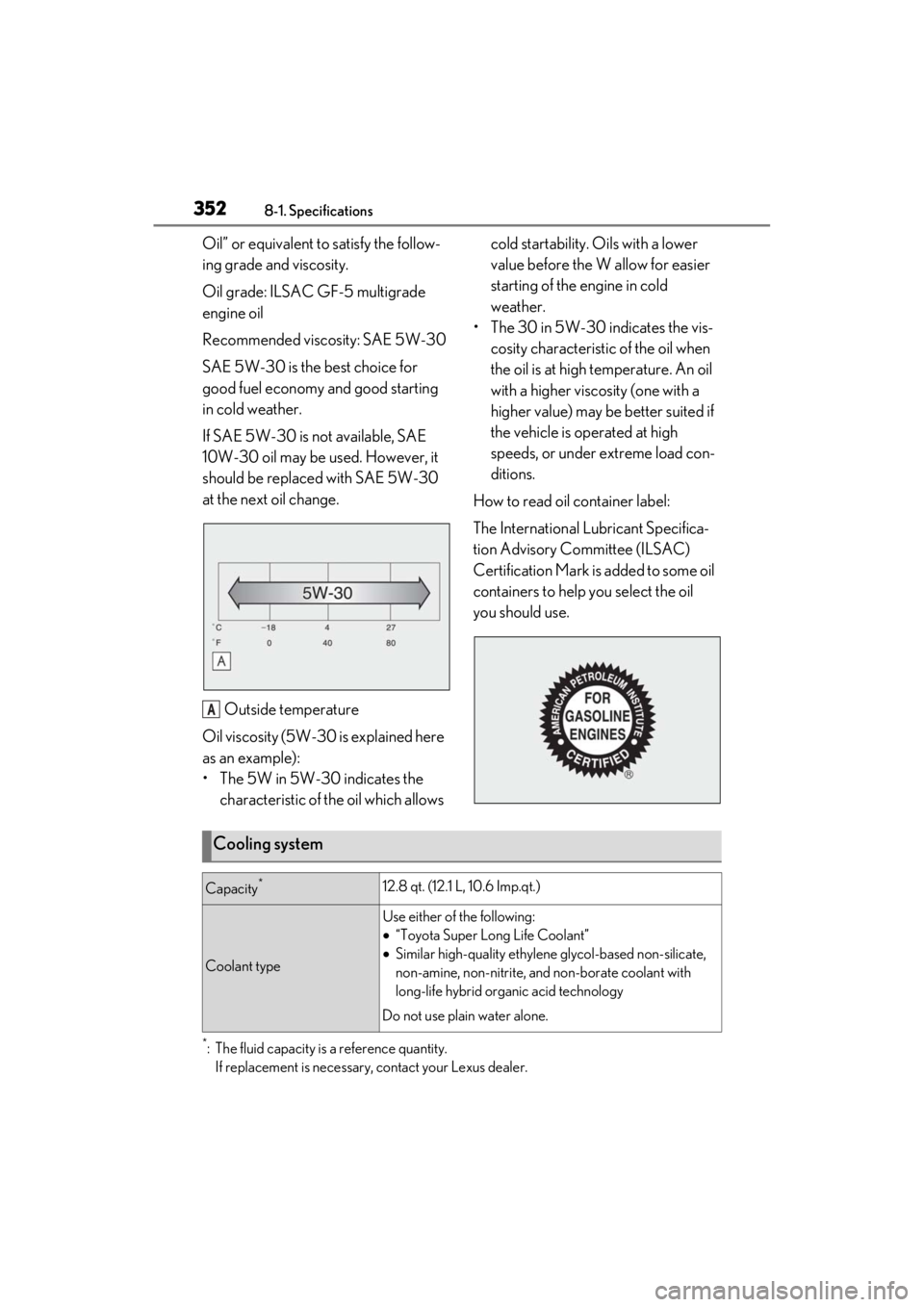
3528-1. Specifications
Oil” or equivalent to satisfy the follow-
ing grade and viscosity.
Oil grade: ILSAC GF-5 multigrade
engine oil
Recommended viscosity: SAE 5W-30
SAE 5W-30 is the best choice for
good fuel economy and good starting
in cold weather.
If SAE 5W-30 is not available, SAE
10W-30 oil may be used. However, it
should be replaced with SAE 5W-30
at the next oil change.Outside temperature
Oil viscosity (5W-30 is explained here
as an example):
• The 5W in 5W-30 indicates the characteristic of the oil which allows cold startability. Oils with a lower
value before the W allow for easier
starting of the engine in cold
weather.
• The 30 in 5W-30 indicates the vis- cosity characteristic of the oil when
the oil is at high temperature. An oil
with a higher viscosity (one with a
higher value) may be better suited if
the vehicle is operated at high
speeds, or under extreme load con-
ditions.
How to read oil container label:
The International Lubricant Specifica-
tion Advisory Committee (ILSAC)
Certification Mark is added to some oil
containers to help you select the oil
you should use.
*: The fluid capacity is a reference quantity. If replacement is necessary, contact your Lexus dealer.
A
Cooling system
Capacity*12.8 qt. (12.1 L, 10.6 Imp.qt.)
Coolant type
Use either of the following:
“Toyota Super Long Life Coolant”
Similar high-quality ethylene glycol-based non-silicate,
non-amine, non-nitrite, and non-borate coolant with
long-life hybrid orga nic acid technology
Do not use plain water alone.
Page 365 of 410
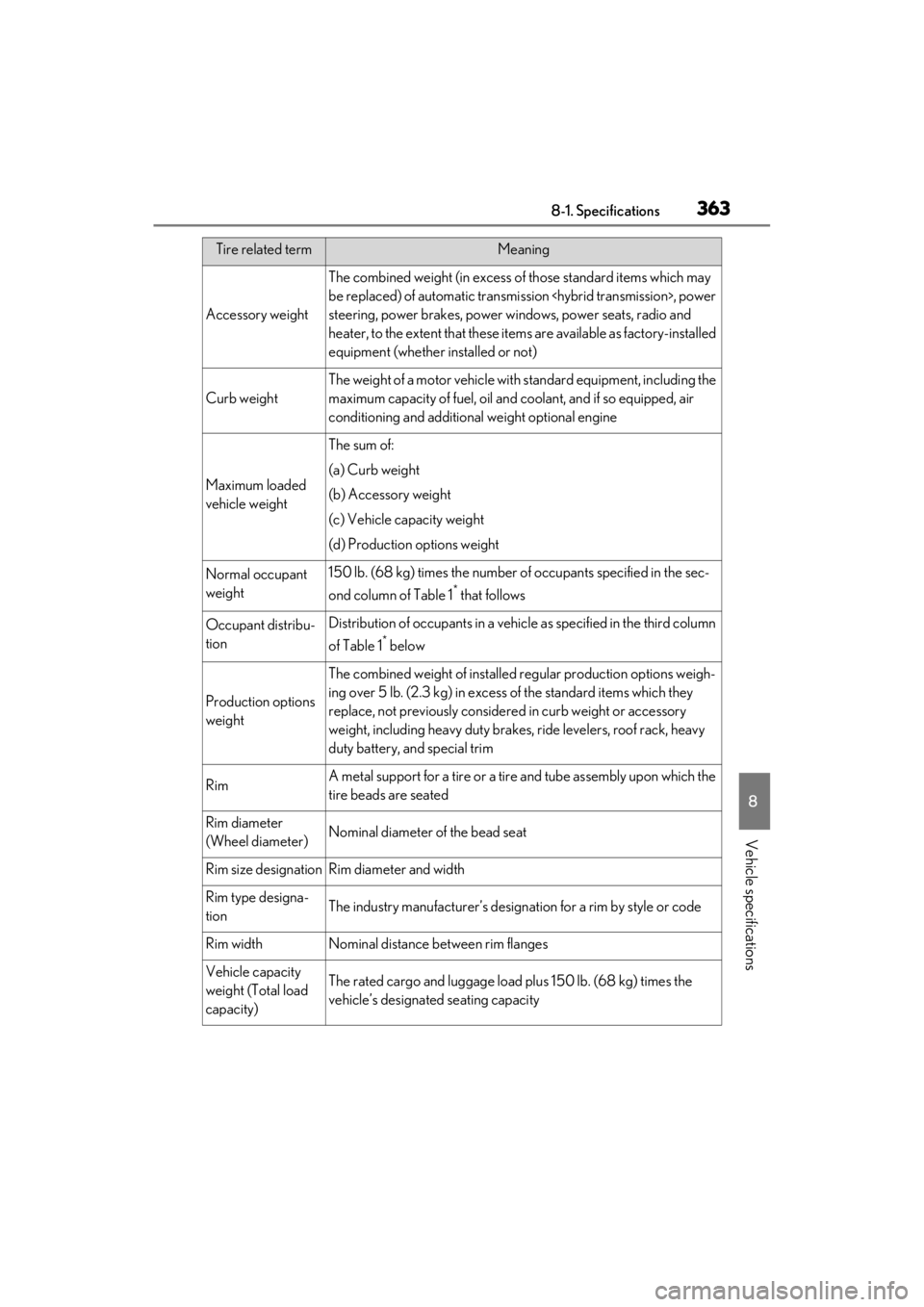
3638-1. Specifications
8
Vehicle specifications
Accessory weight
The combined weight (in excess of those standard items which may
be replaced) of automatic transmission
steering, power brakes, power wi ndows, power seats, radio and
heater, to the extent that these item s are available as factory-installed
equipment (whether installed or not)
Curb weight
The weight of a motor vehicle with standard equipment, including the
maximum capacity of fuel, oil and coolant, and if so equipped, air
conditioning and additional weight optional engine
Maximum loaded
vehicle weight
The sum of:
(a) Curb weight
(b) Accessory weight
(c) Vehicle capacity weight
(d) Production options weight
Normal occupant
weight150 lb. (68 kg) times the number of occupants specified in the sec-
ond column of Table 1
* that follows
Occupant distribu-
tionDistribution of occupants in a vehicl e as specified in the third column
of Table 1
* below
Production options
weight
The combined weight of installed regular production options weigh-
ing over 5 lb. (2.3 kg) in excess of the standard items which they
replace, not previously considered in curb weight or accessory
weight, including heavy duty brakes , ride levelers, roof rack, heavy
duty battery, and special trim
RimA metal support for a tire or a tire and tube assembly upon which the
tire beads are seated
Rim diameter
(Wheel diameter)Nominal diameter of the bead seat
Rim size designationRim diameter and width
Rim type designa-
tionThe industry manufacturer’s designation for a rim by style or code
Rim widthNominal distance between rim flanges
Vehicle capacity
weight (Total load
capacity)The rated cargo and luggage load plus 150 lb. (68 kg) times the
vehicle’s designated seating capacity
Tire related termMeaning